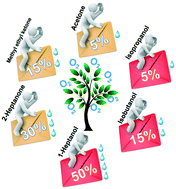Integrated adsorption and photocatalytic degradation of VOCs using a TiO2/diatomite composite: effects of relative humidity and reaction atmosphere
Abstract
In this study, the adsorption and photocatalytic degradation performances of a TiO2/diatomite composite were investigated using ketones and alcohols with different carbon chain lengths as target pollutants. The effects of relative humidity and oxygen on the photocatalytic process of the composite and the different roles of water vapor and oxygen in this process were investigated. The adsorption capacity of VOCs over the composite decreased exponentially with the increase of relative humidity. During the degradation of the ketones and alcohols using the composite, the optimal relative humidity condition for VOC degradation was related to the length of the carbon chain. The optimal relative humidity for acetone, 2-butanone, and 2-heptanone degradation was 5%, 15%, and 30%, respectively. For the tested alcohols, the optimal relative humidity for degradation of isopropanol, isobutanol, and 1-heptanol was 5%, 15%, and 50%, respectively. When dry air was used, a high VOC degradation rate was observed. However, at the optimum relative humidity but in the absence of oxygen, VOC degradation hardly occurred. Compared with water vapor, oxygen played a more important role in the photocatalytic degradation of ketones and alcohols by the TiO2/diatomite composite.



 Please wait while we load your content...
Please wait while we load your content...